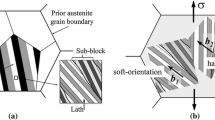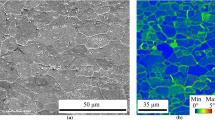Conclusions
Investigations of the mechanical and physical properties of metals at different loading rates and temperatures confirmed the existence of two types of hardening which differ in their physical nature — dislocation-substructural and diffusion.
Diffusion hardening is practicable under conditions of programmed loading in which the rate of increase of external stress equals the rate of diffusion transfer of lattice defects. The structure of metals hardened by programmed loading is more uniform and mechanically more stable with respect to the original as the result of diffusion redistribution of point and line defects, pinning of dislocations, and the removal of local stress concentrations because of microplasticity, leading to release of dislocation pile-ups and their movement to the boundaries. The elimination of weak places with stress concentrations and the removal of structural heterogeneities (regions of potential nucleation of brittle cracks) after programmed loading is indicated by the uniform distribution of slip traces, improvement of the plastic properties, reduction of the static cold brittleness threshold, suppression of the Bauschinger effect, etc. The existence of the effect of programmed hardening in pure metals, the increase of the resistance to deformation without reduction of the plasticity, an improvement of the plastic properties for some metals, little change in the internal friction of iron in the temperature region of the carbon peak, and other results of the investigation indicate the fundamental difference between the mechanism of programmed hardening and ordinary age-hardening.
The distinguishing characteristics of the method of programmed hardening are the increased resistance to deformation and simultaneous improvement of the combination of physical properties, the higher margin of plasticity, the stability of the microstructure with respect to recrystallization, the attainment of hardening with very small remanent strain (0.01–0.5%).
Similar content being viewed by others
Literature cited
Mechanisms of Hardening Solid Materials [in Russian], Metallurgiya (1965).
H. Widersich, J. Metals,16, No.4 (1964).
R. I. Garber and I. A. Gindin, Fiz. Tverd. Tela,1, No.5 (1959).
R. I. Garber and I. A. Gindin, Usp. Fiz. Nauk,70, No.1 (1960).
R. I. Garber, I. M. Neklyudov, and L. M. Perunina, Fiz. Met. i Metallov,11, No.1 (1961).
V. S. Ivanova and L. K. Gordienko, New Methods of Increasing the Strength in Solid State [in Russian], Izd. Aked. Nauk SSSR (1964).
R. I. Garber, I. A. Gindin, I. M. Neklyudov, et al., Zavodsk. Lab., No.1 (1962).
R. I. Garber, I. A. Gindin, and I. M. Neklyudov, Fiz. Met. i Metallov,15, No.3 (1963).
R. I. Garber, I. A. Gindin, and I. M. Neklyudov, Fiz. Met. i Metallov,15, No.6 (1963).
R. I. Garber, I. A. Gindin, et al., Fiz. Met. i Metallov,18, No.3 (1964).
I. A. Gindin, I. M. Neklyudov, and D. F. Smelova, Fiz. Met. i Metallov,19, No.4 (1965).
R. I. Garber, I. A. Gindin, I. M. Neklyudov, and D. F. Smelova, Kristallografiya,10, No.3 (1965).
P. A. Bezuglyi, I. A. Gindin, et al., Fiz. Tverd. Tela,8, No.3 (1966).
I. A. Gindin, I. M. Neklyudov, et al., Fiz. Met. i Metallov,21, No.5 (1966).
A. Granato and K. Lücke, J. Appl. Phys.,28, No.3 (1956).
P. Pratt, K. Bratina, and B. Chalmers, Acta Met., No.2 (1964).
R. I. Garber, I. A. Gindin, and Yu. V. Shubin, Fiz. Tverd. Tela,5, No.3 (1963).
D. M. Vasil'ev, In: Some Problems of the Strength in Solid State [in Russian] (1959).
Additional information
Physicotechnical Institute of the Academmy of Sciences of the UkrSSR. Translated from Metallovedenie i Termicheskaya Obrabotka Metallov, No.5, pp.2–8, May, 1967.
Rights and permissions
About this article
Cite this article
Garber, R.I., Gindin, I.A. & Neklyudov, I.M. Strengthening of crystalline substances by programmed strain hardening. Met Sci Heat Treat 9, 334–338 (1967). https://doi.org/10.1007/BF00655022
Issue Date:
DOI: https://doi.org/10.1007/BF00655022




